International Strategic Alliances: Strategies for Effectiveness Essay
VerifiedAdded on 2021/04/19
|8
|1840
|131
Essay
AI Summary
This essay delves into the complexities of international strategic alliances, highlighting the challenges multinational organizations face, particularly in navigating cross-cultural issues. The paper identifies five key steps to enhance alliance effectiveness, including initiating a clear strategy, conducting a cost-benefit analysis, selecting suitable host country partners, considering mutual interests, and implementing a continuous evaluation process. It emphasizes the importance of strategic partner selection, aligning organizational goals, and ensuring mutual benefits for all partners involved. The essay underscores the need for shared management and collaborative decision-making to foster successful and sustainable international strategic alliances. The paper references various academic sources to support its arguments.
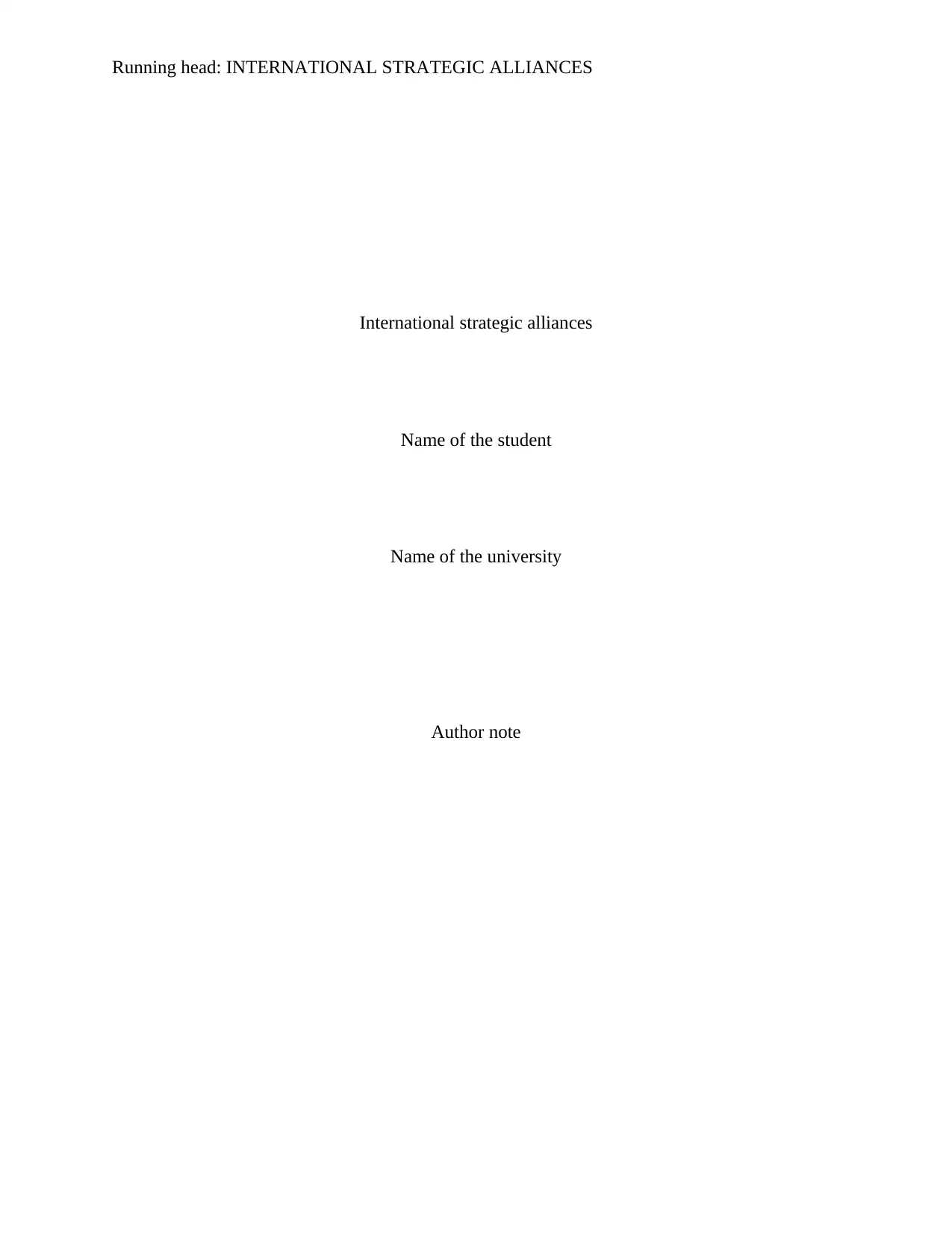
Running head: INTERNATIONAL STRATEGIC ALLIANCES
International strategic alliances
Name of the student
Name of the university
Author note
International strategic alliances
Name of the student
Name of the university
Author note
Paraphrase This Document
Need a fresh take? Get an instant paraphrase of this document with our AI Paraphraser
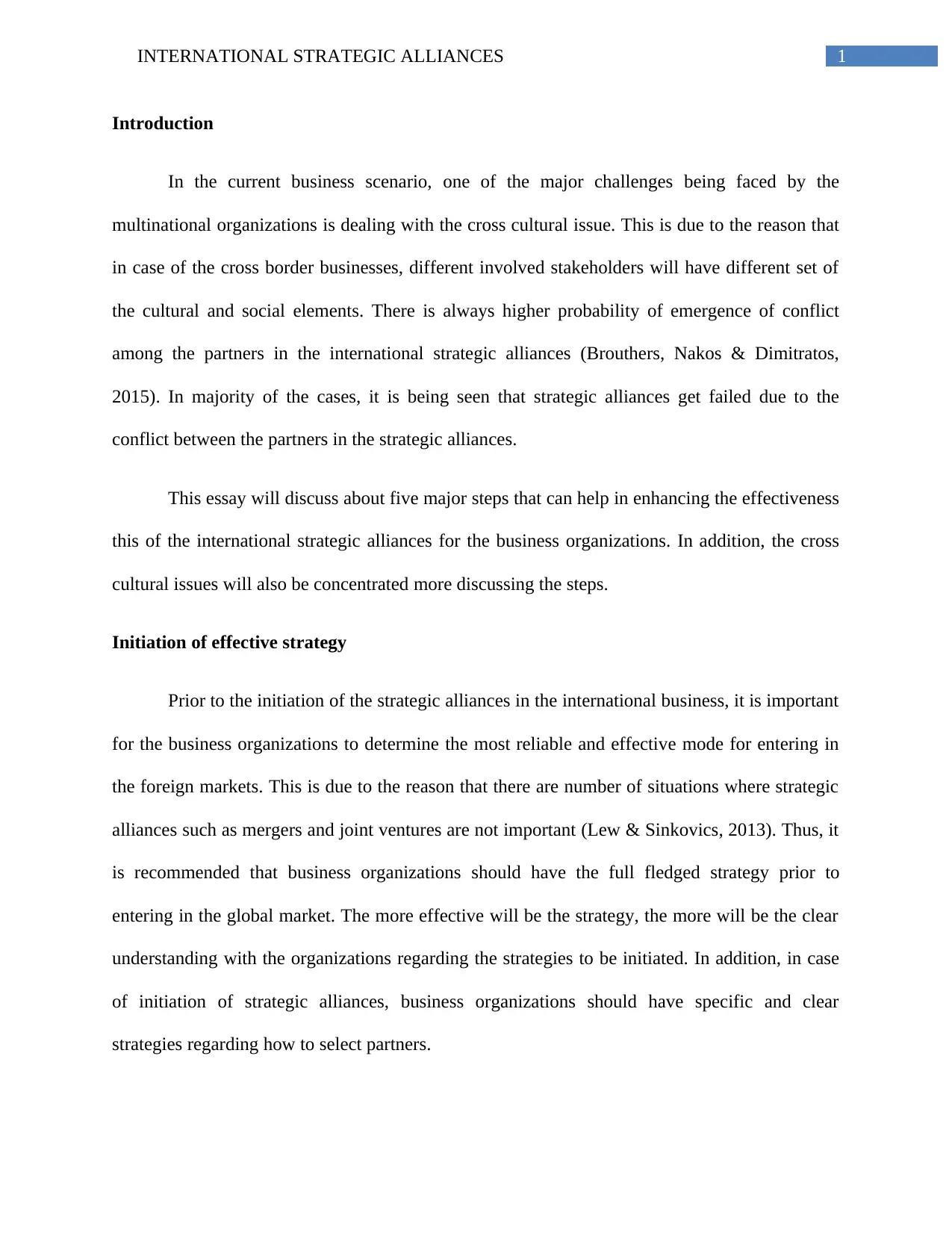
1INTERNATIONAL STRATEGIC ALLIANCES
Introduction
In the current business scenario, one of the major challenges being faced by the
multinational organizations is dealing with the cross cultural issue. This is due to the reason that
in case of the cross border businesses, different involved stakeholders will have different set of
the cultural and social elements. There is always higher probability of emergence of conflict
among the partners in the international strategic alliances (Brouthers, Nakos & Dimitratos,
2015). In majority of the cases, it is being seen that strategic alliances get failed due to the
conflict between the partners in the strategic alliances.
This essay will discuss about five major steps that can help in enhancing the effectiveness
this of the international strategic alliances for the business organizations. In addition, the cross
cultural issues will also be concentrated more discussing the steps.
Initiation of effective strategy
Prior to the initiation of the strategic alliances in the international business, it is important
for the business organizations to determine the most reliable and effective mode for entering in
the foreign markets. This is due to the reason that there are number of situations where strategic
alliances such as mergers and joint ventures are not important (Lew & Sinkovics, 2013). Thus, it
is recommended that business organizations should have the full fledged strategy prior to
entering in the global market. The more effective will be the strategy, the more will be the clear
understanding with the organizations regarding the strategies to be initiated. In addition, in case
of initiation of strategic alliances, business organizations should have specific and clear
strategies regarding how to select partners.
Introduction
In the current business scenario, one of the major challenges being faced by the
multinational organizations is dealing with the cross cultural issue. This is due to the reason that
in case of the cross border businesses, different involved stakeholders will have different set of
the cultural and social elements. There is always higher probability of emergence of conflict
among the partners in the international strategic alliances (Brouthers, Nakos & Dimitratos,
2015). In majority of the cases, it is being seen that strategic alliances get failed due to the
conflict between the partners in the strategic alliances.
This essay will discuss about five major steps that can help in enhancing the effectiveness
this of the international strategic alliances for the business organizations. In addition, the cross
cultural issues will also be concentrated more discussing the steps.
Initiation of effective strategy
Prior to the initiation of the strategic alliances in the international business, it is important
for the business organizations to determine the most reliable and effective mode for entering in
the foreign markets. This is due to the reason that there are number of situations where strategic
alliances such as mergers and joint ventures are not important (Lew & Sinkovics, 2013). Thus, it
is recommended that business organizations should have the full fledged strategy prior to
entering in the global market. The more effective will be the strategy, the more will be the clear
understanding with the organizations regarding the strategies to be initiated. In addition, in case
of initiation of strategic alliances, business organizations should have specific and clear
strategies regarding how to select partners.
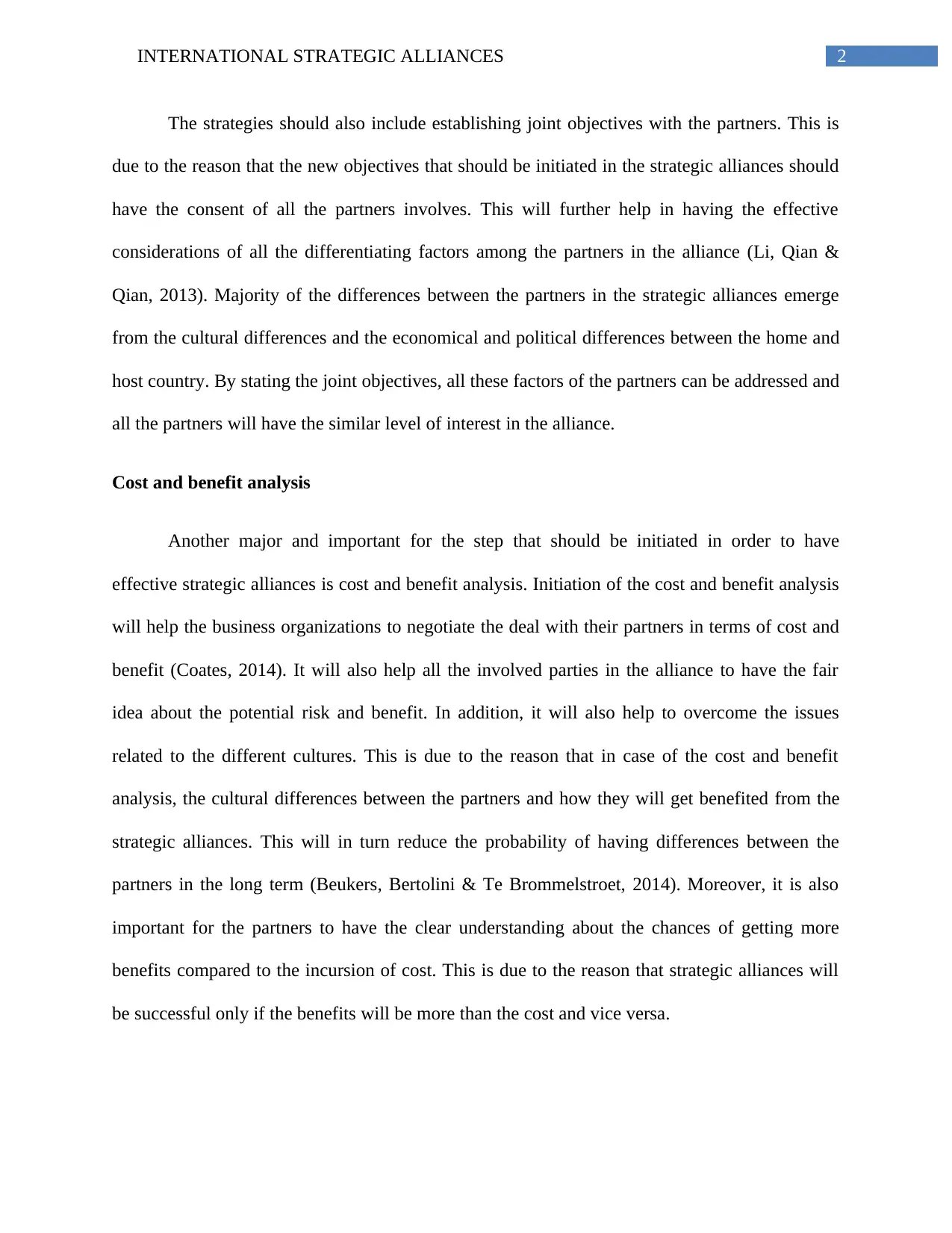
2INTERNATIONAL STRATEGIC ALLIANCES
The strategies should also include establishing joint objectives with the partners. This is
due to the reason that the new objectives that should be initiated in the strategic alliances should
have the consent of all the partners involves. This will further help in having the effective
considerations of all the differentiating factors among the partners in the alliance (Li, Qian &
Qian, 2013). Majority of the differences between the partners in the strategic alliances emerge
from the cultural differences and the economical and political differences between the home and
host country. By stating the joint objectives, all these factors of the partners can be addressed and
all the partners will have the similar level of interest in the alliance.
Cost and benefit analysis
Another major and important for the step that should be initiated in order to have
effective strategic alliances is cost and benefit analysis. Initiation of the cost and benefit analysis
will help the business organizations to negotiate the deal with their partners in terms of cost and
benefit (Coates, 2014). It will also help all the involved parties in the alliance to have the fair
idea about the potential risk and benefit. In addition, it will also help to overcome the issues
related to the different cultures. This is due to the reason that in case of the cost and benefit
analysis, the cultural differences between the partners and how they will get benefited from the
strategic alliances. This will in turn reduce the probability of having differences between the
partners in the long term (Beukers, Bertolini & Te Brommelstroet, 2014). Moreover, it is also
important for the partners to have the clear understanding about the chances of getting more
benefits compared to the incursion of cost. This is due to the reason that strategic alliances will
be successful only if the benefits will be more than the cost and vice versa.
The strategies should also include establishing joint objectives with the partners. This is
due to the reason that the new objectives that should be initiated in the strategic alliances should
have the consent of all the partners involves. This will further help in having the effective
considerations of all the differentiating factors among the partners in the alliance (Li, Qian &
Qian, 2013). Majority of the differences between the partners in the strategic alliances emerge
from the cultural differences and the economical and political differences between the home and
host country. By stating the joint objectives, all these factors of the partners can be addressed and
all the partners will have the similar level of interest in the alliance.
Cost and benefit analysis
Another major and important for the step that should be initiated in order to have
effective strategic alliances is cost and benefit analysis. Initiation of the cost and benefit analysis
will help the business organizations to negotiate the deal with their partners in terms of cost and
benefit (Coates, 2014). It will also help all the involved parties in the alliance to have the fair
idea about the potential risk and benefit. In addition, it will also help to overcome the issues
related to the different cultures. This is due to the reason that in case of the cost and benefit
analysis, the cultural differences between the partners and how they will get benefited from the
strategic alliances. This will in turn reduce the probability of having differences between the
partners in the long term (Beukers, Bertolini & Te Brommelstroet, 2014). Moreover, it is also
important for the partners to have the clear understanding about the chances of getting more
benefits compared to the incursion of cost. This is due to the reason that strategic alliances will
be successful only if the benefits will be more than the cost and vice versa.
⊘ This is a preview!⊘
Do you want full access?
Subscribe today to unlock all pages.

Trusted by 1+ million students worldwide
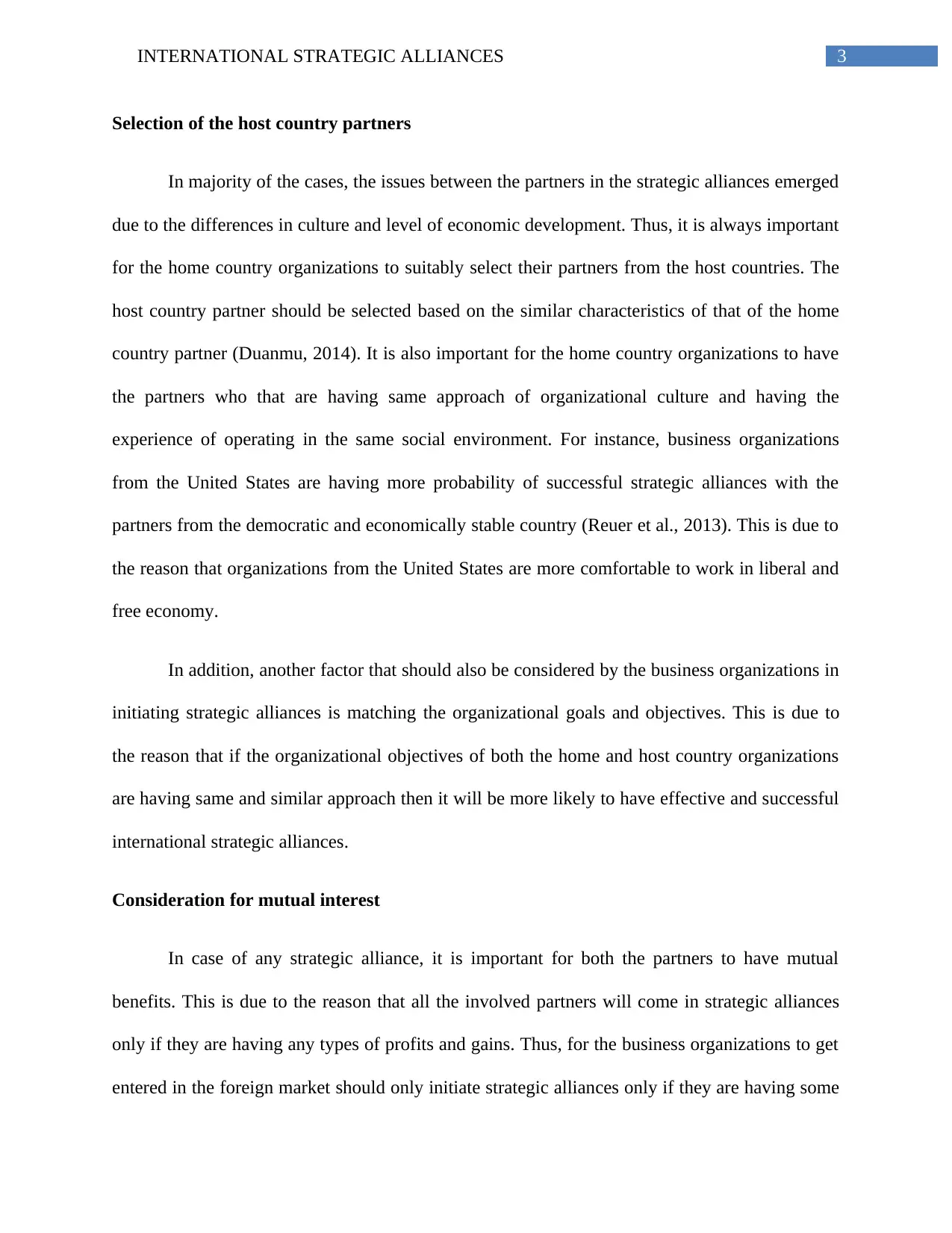
3INTERNATIONAL STRATEGIC ALLIANCES
Selection of the host country partners
In majority of the cases, the issues between the partners in the strategic alliances emerged
due to the differences in culture and level of economic development. Thus, it is always important
for the home country organizations to suitably select their partners from the host countries. The
host country partner should be selected based on the similar characteristics of that of the home
country partner (Duanmu, 2014). It is also important for the home country organizations to have
the partners who that are having same approach of organizational culture and having the
experience of operating in the same social environment. For instance, business organizations
from the United States are having more probability of successful strategic alliances with the
partners from the democratic and economically stable country (Reuer et al., 2013). This is due to
the reason that organizations from the United States are more comfortable to work in liberal and
free economy.
In addition, another factor that should also be considered by the business organizations in
initiating strategic alliances is matching the organizational goals and objectives. This is due to
the reason that if the organizational objectives of both the home and host country organizations
are having same and similar approach then it will be more likely to have effective and successful
international strategic alliances.
Consideration for mutual interest
In case of any strategic alliance, it is important for both the partners to have mutual
benefits. This is due to the reason that all the involved partners will come in strategic alliances
only if they are having any types of profits and gains. Thus, for the business organizations to get
entered in the foreign market should only initiate strategic alliances only if they are having some
Selection of the host country partners
In majority of the cases, the issues between the partners in the strategic alliances emerged
due to the differences in culture and level of economic development. Thus, it is always important
for the home country organizations to suitably select their partners from the host countries. The
host country partner should be selected based on the similar characteristics of that of the home
country partner (Duanmu, 2014). It is also important for the home country organizations to have
the partners who that are having same approach of organizational culture and having the
experience of operating in the same social environment. For instance, business organizations
from the United States are having more probability of successful strategic alliances with the
partners from the democratic and economically stable country (Reuer et al., 2013). This is due to
the reason that organizations from the United States are more comfortable to work in liberal and
free economy.
In addition, another factor that should also be considered by the business organizations in
initiating strategic alliances is matching the organizational goals and objectives. This is due to
the reason that if the organizational objectives of both the home and host country organizations
are having same and similar approach then it will be more likely to have effective and successful
international strategic alliances.
Consideration for mutual interest
In case of any strategic alliance, it is important for both the partners to have mutual
benefits. This is due to the reason that all the involved partners will come in strategic alliances
only if they are having any types of profits and gains. Thus, for the business organizations to get
entered in the foreign market should only initiate strategic alliances only if they are having some
Paraphrase This Document
Need a fresh take? Get an instant paraphrase of this document with our AI Paraphraser
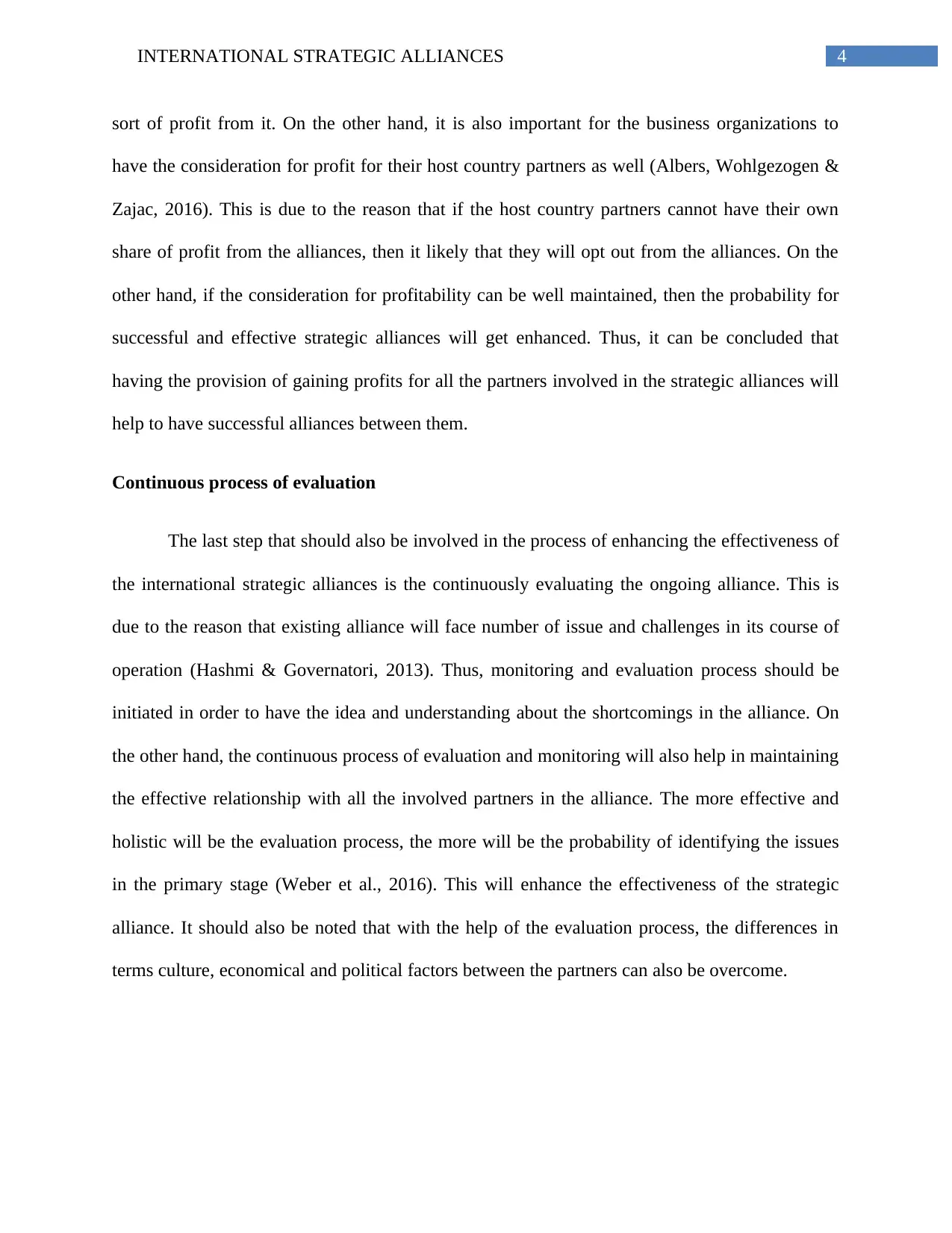
4INTERNATIONAL STRATEGIC ALLIANCES
sort of profit from it. On the other hand, it is also important for the business organizations to
have the consideration for profit for their host country partners as well (Albers, Wohlgezogen &
Zajac, 2016). This is due to the reason that if the host country partners cannot have their own
share of profit from the alliances, then it likely that they will opt out from the alliances. On the
other hand, if the consideration for profitability can be well maintained, then the probability for
successful and effective strategic alliances will get enhanced. Thus, it can be concluded that
having the provision of gaining profits for all the partners involved in the strategic alliances will
help to have successful alliances between them.
Continuous process of evaluation
The last step that should also be involved in the process of enhancing the effectiveness of
the international strategic alliances is the continuously evaluating the ongoing alliance. This is
due to the reason that existing alliance will face number of issue and challenges in its course of
operation (Hashmi & Governatori, 2013). Thus, monitoring and evaluation process should be
initiated in order to have the idea and understanding about the shortcomings in the alliance. On
the other hand, the continuous process of evaluation and monitoring will also help in maintaining
the effective relationship with all the involved partners in the alliance. The more effective and
holistic will be the evaluation process, the more will be the probability of identifying the issues
in the primary stage (Weber et al., 2016). This will enhance the effectiveness of the strategic
alliance. It should also be noted that with the help of the evaluation process, the differences in
terms culture, economical and political factors between the partners can also be overcome.
sort of profit from it. On the other hand, it is also important for the business organizations to
have the consideration for profit for their host country partners as well (Albers, Wohlgezogen &
Zajac, 2016). This is due to the reason that if the host country partners cannot have their own
share of profit from the alliances, then it likely that they will opt out from the alliances. On the
other hand, if the consideration for profitability can be well maintained, then the probability for
successful and effective strategic alliances will get enhanced. Thus, it can be concluded that
having the provision of gaining profits for all the partners involved in the strategic alliances will
help to have successful alliances between them.
Continuous process of evaluation
The last step that should also be involved in the process of enhancing the effectiveness of
the international strategic alliances is the continuously evaluating the ongoing alliance. This is
due to the reason that existing alliance will face number of issue and challenges in its course of
operation (Hashmi & Governatori, 2013). Thus, monitoring and evaluation process should be
initiated in order to have the idea and understanding about the shortcomings in the alliance. On
the other hand, the continuous process of evaluation and monitoring will also help in maintaining
the effective relationship with all the involved partners in the alliance. The more effective and
holistic will be the evaluation process, the more will be the probability of identifying the issues
in the primary stage (Weber et al., 2016). This will enhance the effectiveness of the strategic
alliance. It should also be noted that with the help of the evaluation process, the differences in
terms culture, economical and political factors between the partners can also be overcome.
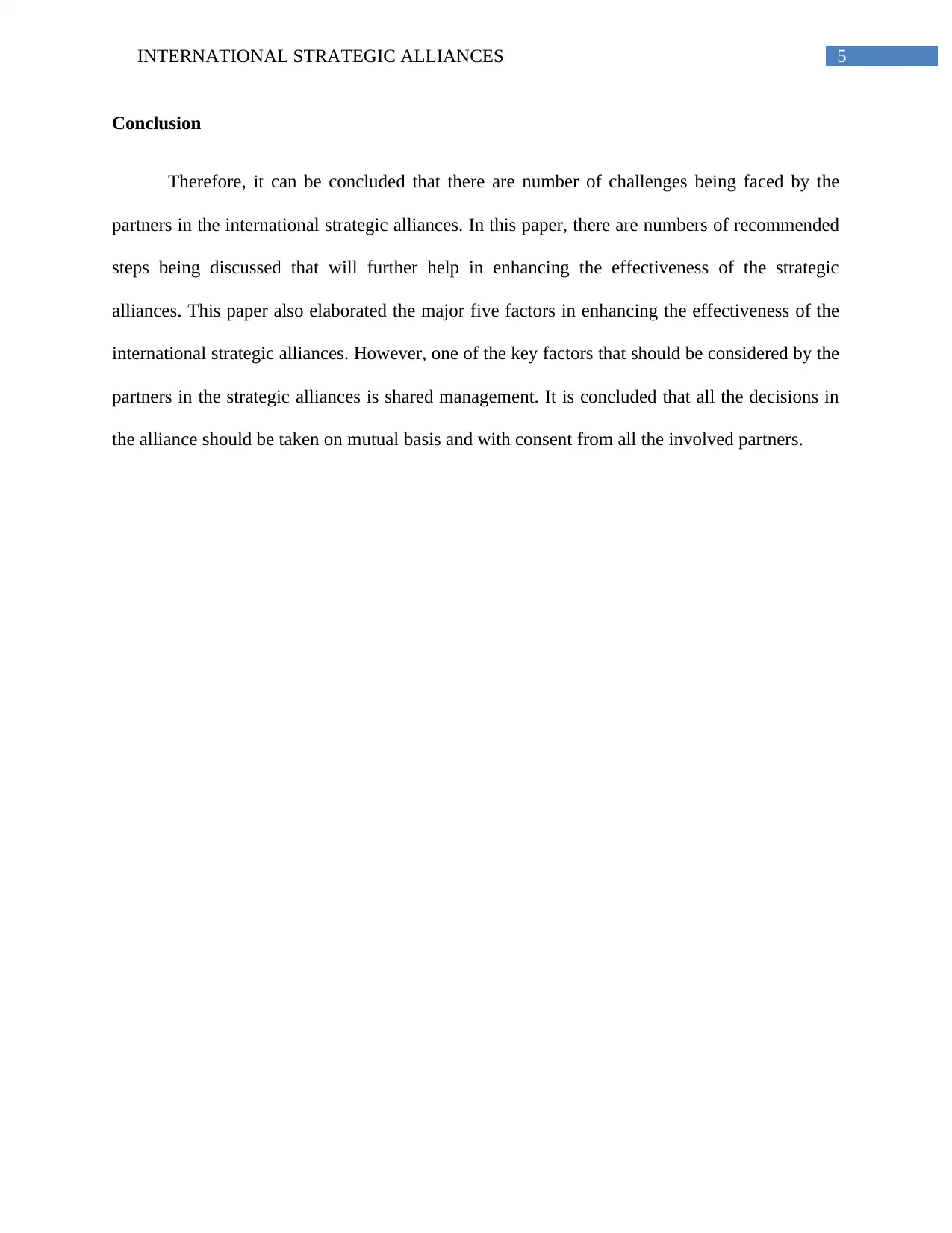
5INTERNATIONAL STRATEGIC ALLIANCES
Conclusion
Therefore, it can be concluded that there are number of challenges being faced by the
partners in the international strategic alliances. In this paper, there are numbers of recommended
steps being discussed that will further help in enhancing the effectiveness of the strategic
alliances. This paper also elaborated the major five factors in enhancing the effectiveness of the
international strategic alliances. However, one of the key factors that should be considered by the
partners in the strategic alliances is shared management. It is concluded that all the decisions in
the alliance should be taken on mutual basis and with consent from all the involved partners.
Conclusion
Therefore, it can be concluded that there are number of challenges being faced by the
partners in the international strategic alliances. In this paper, there are numbers of recommended
steps being discussed that will further help in enhancing the effectiveness of the strategic
alliances. This paper also elaborated the major five factors in enhancing the effectiveness of the
international strategic alliances. However, one of the key factors that should be considered by the
partners in the strategic alliances is shared management. It is concluded that all the decisions in
the alliance should be taken on mutual basis and with consent from all the involved partners.
⊘ This is a preview!⊘
Do you want full access?
Subscribe today to unlock all pages.

Trusted by 1+ million students worldwide
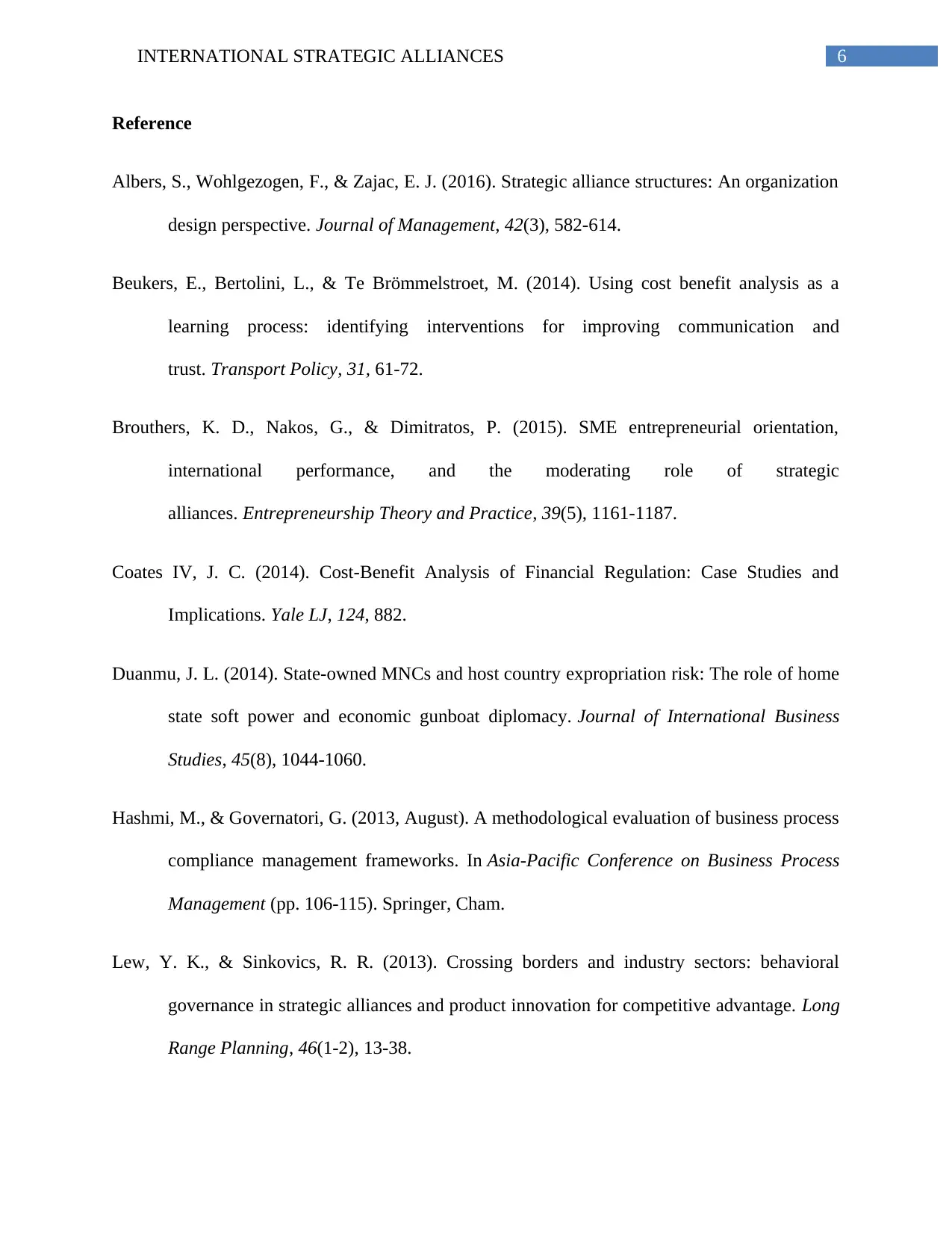
6INTERNATIONAL STRATEGIC ALLIANCES
Reference
Albers, S., Wohlgezogen, F., & Zajac, E. J. (2016). Strategic alliance structures: An organization
design perspective. Journal of Management, 42(3), 582-614.
Beukers, E., Bertolini, L., & Te Brömmelstroet, M. (2014). Using cost benefit analysis as a
learning process: identifying interventions for improving communication and
trust. Transport Policy, 31, 61-72.
Brouthers, K. D., Nakos, G., & Dimitratos, P. (2015). SME entrepreneurial orientation,
international performance, and the moderating role of strategic
alliances. Entrepreneurship Theory and Practice, 39(5), 1161-1187.
Coates IV, J. C. (2014). Cost-Benefit Analysis of Financial Regulation: Case Studies and
Implications. Yale LJ, 124, 882.
Duanmu, J. L. (2014). State-owned MNCs and host country expropriation risk: The role of home
state soft power and economic gunboat diplomacy. Journal of International Business
Studies, 45(8), 1044-1060.
Hashmi, M., & Governatori, G. (2013, August). A methodological evaluation of business process
compliance management frameworks. In Asia-Pacific Conference on Business Process
Management (pp. 106-115). Springer, Cham.
Lew, Y. K., & Sinkovics, R. R. (2013). Crossing borders and industry sectors: behavioral
governance in strategic alliances and product innovation for competitive advantage. Long
Range Planning, 46(1-2), 13-38.
Reference
Albers, S., Wohlgezogen, F., & Zajac, E. J. (2016). Strategic alliance structures: An organization
design perspective. Journal of Management, 42(3), 582-614.
Beukers, E., Bertolini, L., & Te Brömmelstroet, M. (2014). Using cost benefit analysis as a
learning process: identifying interventions for improving communication and
trust. Transport Policy, 31, 61-72.
Brouthers, K. D., Nakos, G., & Dimitratos, P. (2015). SME entrepreneurial orientation,
international performance, and the moderating role of strategic
alliances. Entrepreneurship Theory and Practice, 39(5), 1161-1187.
Coates IV, J. C. (2014). Cost-Benefit Analysis of Financial Regulation: Case Studies and
Implications. Yale LJ, 124, 882.
Duanmu, J. L. (2014). State-owned MNCs and host country expropriation risk: The role of home
state soft power and economic gunboat diplomacy. Journal of International Business
Studies, 45(8), 1044-1060.
Hashmi, M., & Governatori, G. (2013, August). A methodological evaluation of business process
compliance management frameworks. In Asia-Pacific Conference on Business Process
Management (pp. 106-115). Springer, Cham.
Lew, Y. K., & Sinkovics, R. R. (2013). Crossing borders and industry sectors: behavioral
governance in strategic alliances and product innovation for competitive advantage. Long
Range Planning, 46(1-2), 13-38.
Paraphrase This Document
Need a fresh take? Get an instant paraphrase of this document with our AI Paraphraser
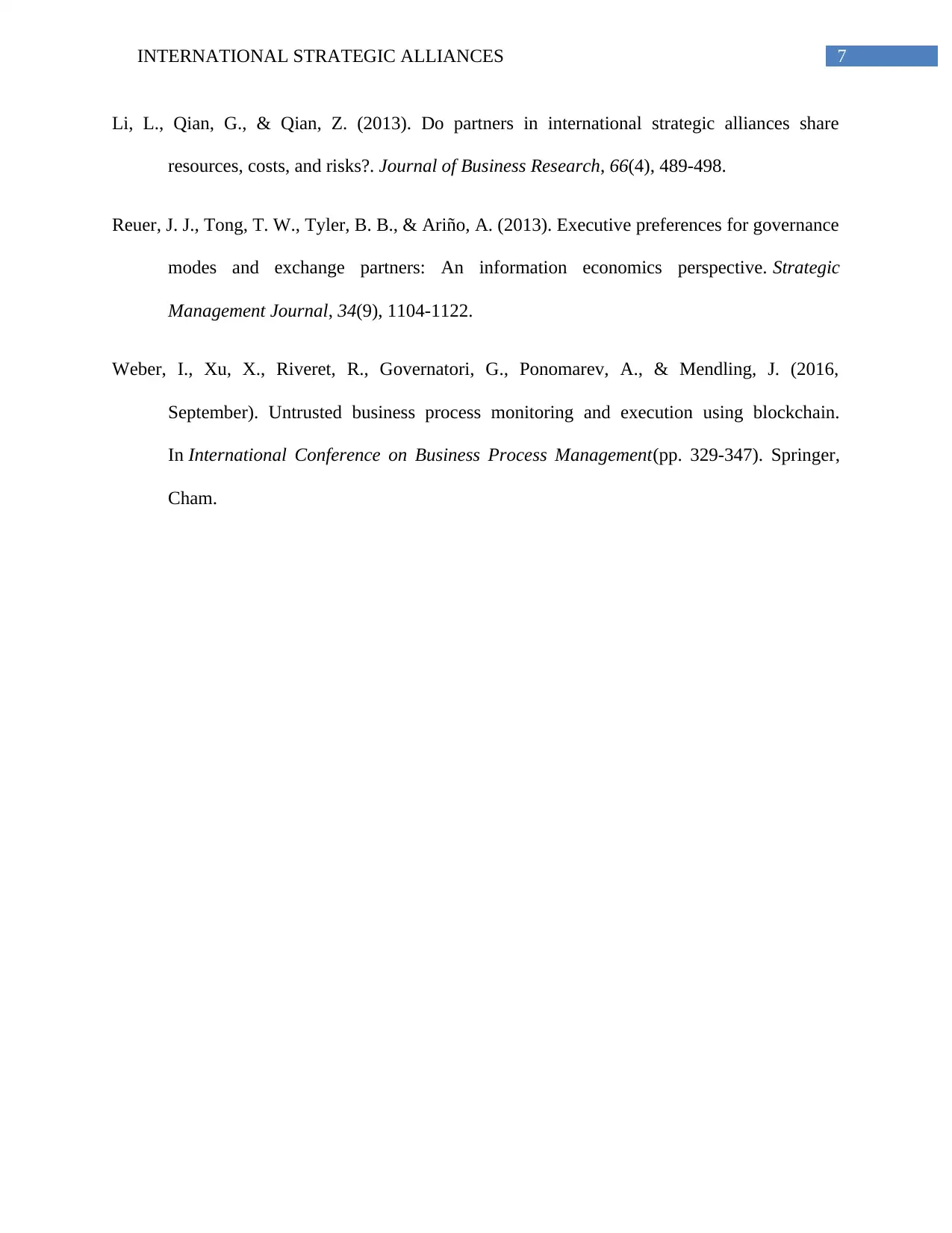
7INTERNATIONAL STRATEGIC ALLIANCES
Li, L., Qian, G., & Qian, Z. (2013). Do partners in international strategic alliances share
resources, costs, and risks?. Journal of Business Research, 66(4), 489-498.
Reuer, J. J., Tong, T. W., Tyler, B. B., & Ariño, A. (2013). Executive preferences for governance
modes and exchange partners: An information economics perspective. Strategic
Management Journal, 34(9), 1104-1122.
Weber, I., Xu, X., Riveret, R., Governatori, G., Ponomarev, A., & Mendling, J. (2016,
September). Untrusted business process monitoring and execution using blockchain.
In International Conference on Business Process Management(pp. 329-347). Springer,
Cham.
Li, L., Qian, G., & Qian, Z. (2013). Do partners in international strategic alliances share
resources, costs, and risks?. Journal of Business Research, 66(4), 489-498.
Reuer, J. J., Tong, T. W., Tyler, B. B., & Ariño, A. (2013). Executive preferences for governance
modes and exchange partners: An information economics perspective. Strategic
Management Journal, 34(9), 1104-1122.
Weber, I., Xu, X., Riveret, R., Governatori, G., Ponomarev, A., & Mendling, J. (2016,
September). Untrusted business process monitoring and execution using blockchain.
In International Conference on Business Process Management(pp. 329-347). Springer,
Cham.
1 out of 8
Related Documents
Your All-in-One AI-Powered Toolkit for Academic Success.
+13062052269
info@desklib.com
Available 24*7 on WhatsApp / Email
![[object Object]](/_next/static/media/star-bottom.7253800d.svg)
Unlock your academic potential
Copyright © 2020–2025 A2Z Services. All Rights Reserved. Developed and managed by ZUCOL.





